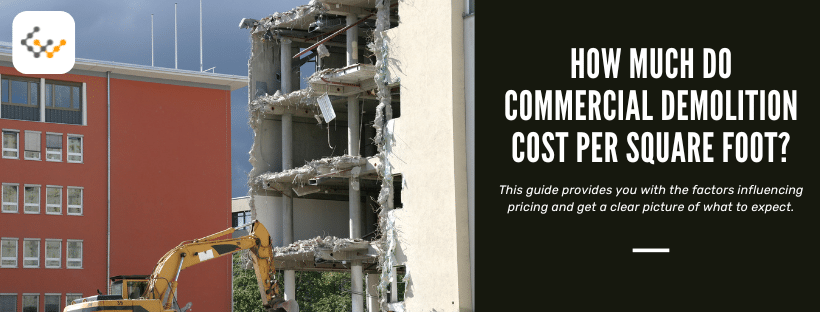How Much Do Commercial Demolition Cost Per Square Foot?

Investors typically need to take into consideration a wide range of factors before purchasing property, including the cost to demolish existing structures that may no longer fit the specific needs and objectives of the land’s use going forward. Calculating the value property while factoring in demolition cost is critical to do this.
What is the Average Cost of Commercial Demolition Per Square Foot?
Typical costs for demolition of commercial property depend on multiple factors. The average cost to demolish commercial property ranges from $4 to $25 per square foot.Consider the following chart as a guideline that applies to most areas of the US:
- 1000 to 5000 square feet: $4 to $8 per square foot
- 5001 to 10,000 square feet: $8 to $12 per square foot
- 10,001 to 20,000 square feet: $12 to $18 per square foot
- 20,001 to 50,000 square feet: $18 to $25 per square foot
- Over 50,000 square feet: $25 or higher per square foot
The national average for the disposal of a commercial building is $24,000. Typically, demolition costs will include:
- Pre-demolition planning and site analysis
- Total or selective demolition of structures
- Demolition and rehabilitation of sites after a fire and industrial explosion needs
- Environmental cleanup factors
- Asbestos removal (typically an added cost when needed)
- Removal of debris and disposal of it
Labor and materials for the project are typically included in a quote. However, there are situations in which additional costs may apply. Contractors for the job should provide a breakdown of all costs involved in the process, including what additional costs may be applicable depending on the specific property type and location. For example, complexity is a factor. Taking down an office building or industrial warehouse tends to be less expensive than removing sports facilities or hazardous materials plants.
5 Factors That Can Affect the Cost of Commercial Demolition
The most significant factor in the cost of demolishing a commercial structure is size. Larger buildings have more material, which influences the overall cost of demolition. However, other factors play a role as well, including the following:
- Geographic location: The cost of demolition depends on location. Costs in urban city centers, such as New York City, tend to be much higher than in smaller cities. Materials and costs in those areas are higher, increasing the overall cost of the demolition process.
- Accessibility of property: Property that is difficult to access due to height or placement will also cause prices to increase. The logistical costs of removing tall buildings themselves tend to be high. Specifically, project managers must consider how easily equipment can reach the structure to remove it in a safe manner.
- Building condition: Buildings that are older may seem easier to take down, but they are more likely to contain hazardous material, including asbestos. If asbestos is found, this could add $2 to $3 per square foot to the cost of the project.
- Disposal costs: The disposal of building materials ranges widely depending on location. Typically, debris removal and disposal will be lower if some materials can be recycled, but the process of sorting out those types of materials can also play a role in cost.
- Size: As noted, building size is a significant factor in determining the overall cost of demolishing a structure. Since most contractors base this decision on the square footage of the space, costs will rise not only for footprints but also for height. Taller buildings cost more to demolish than smaller properties.
Additional Costs to Consider Besides the Demolition Itself
Demolition costs may not include all costs associated with the project. Investors must request a full quote from the project manager or demolition company for all costs included and what may be additional costs. Some examples may include:
- Permitting: Though some contractors may include the cost of obtaining a permit within the demolition cost, that is not always done. It may depend on the city or county requirements and, in some cases, can add several thousand dollars to any project. Some cities discourage demolition and may charge more for those who take these properties down. Some cities may require full site development plans before approving demolition of existing structures.
- Disposal costs: Some landfills and other disposal locations charge more based on the type of material being disposed of. The cost will depend on the type, such as wood or plaster, metal or concrete, as well as the amount of material. If the nearest landfill is some distance away, there are added transportation costs that must also be considered.
- Structural integrity: In some situations, the structural integrity of the property could be a factor in the cost. If a property is not in good condition, it may be necessary for the crew to stabilize it first before they take it down to provide proper safety for workers and to minimize damage to other structures nearby. Demolition procedures are very specific and contractors must maintain safety per OSHA obligations.
- Historical or architectural significance: There are some situations in which a building may cost more to remove due to the methods allowable. For historic or architecturally significant projects, it may take more care and precision to remove key components that are expected to be reused or kept. This adds to the cost because it increases the amount of time necessary for the project.
- Hazardous materials: As noted, asbestos can be a big factor in the added cost of any project. Any building built prior to 1980 must have an asbestos test to ensure it does not contain the material. This test itself has a cost associated to it. If there is any other type of hazardous material present, it also must be removed, cleaned up, and disposed of, which will add to the cost of the project.
How to Get an Accurate Estimate for a Commercial Demolition Project?
The best method for getting an accurate estimate for the demolition of a commercial project is to request a quote. Contractors can offer basic estimates by looking at the structure and considering the overall cost structure based on location, size, and condition. However, true accuracy is only possible with a full analysis and quote from a local contractor who could do the work.
Common Financing Options for Commercial Demolition
Investors ready to take down old structures to build new ones may be able to secure a loan to help cover these costs. Financing the commercial demolition process typically requires a short-term loan. Most are 1- to 3-year loans and can be interest-only.
In many situations, the lender will require that the borrower already have a commitment to a permanent lender to refinance and repay the property. This may be done along with financing the purchase of the property in some situations.

